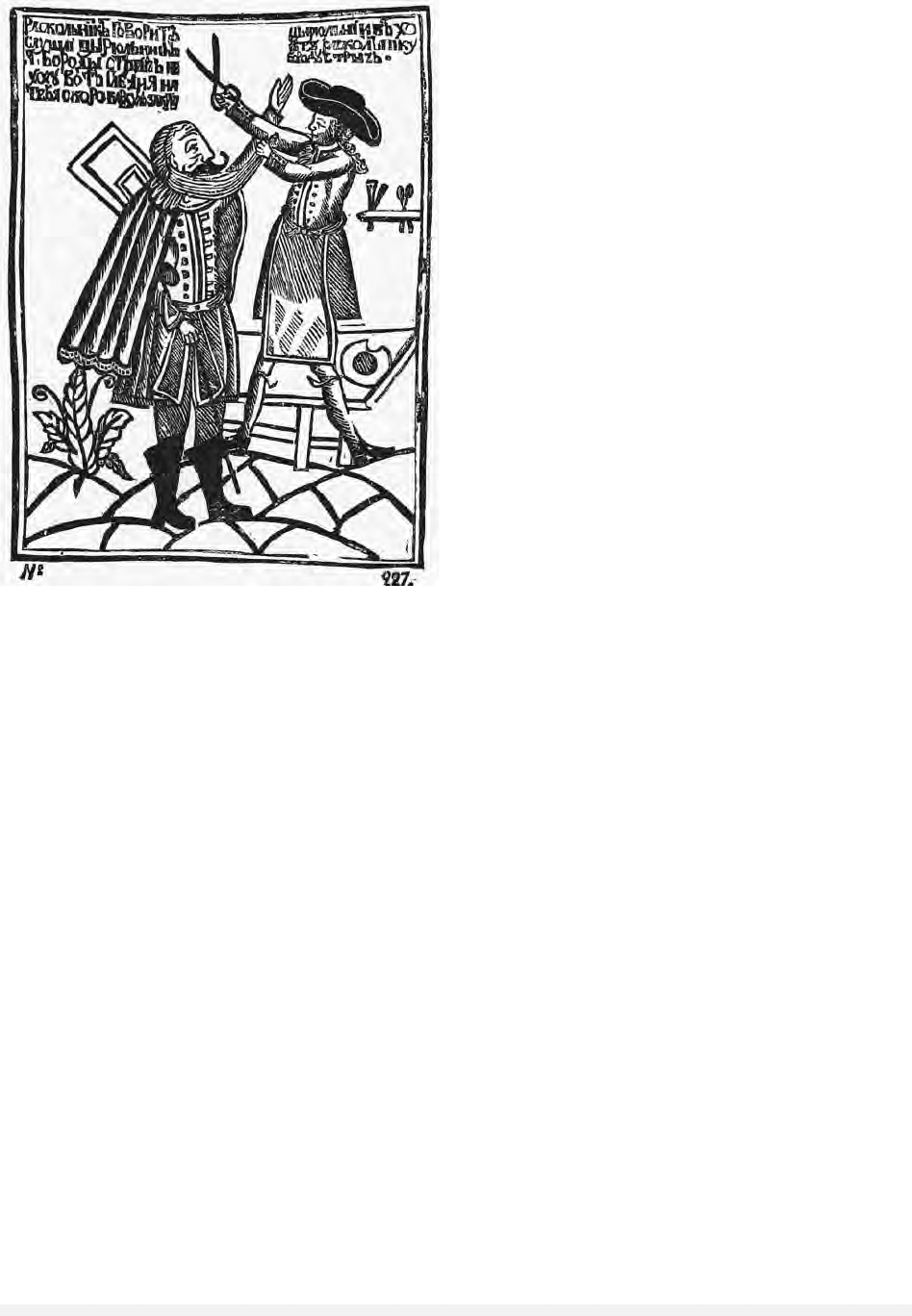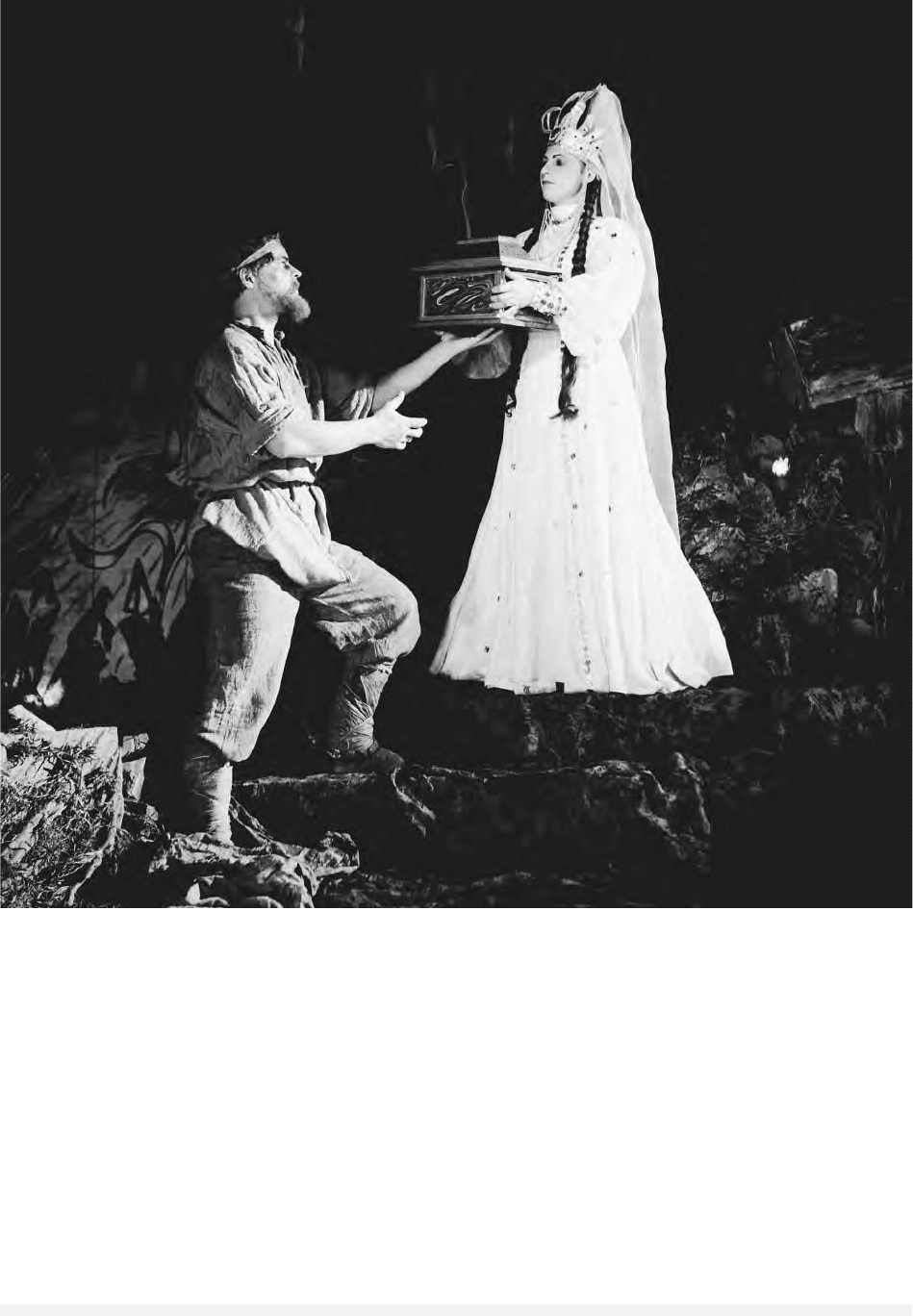Encyclopedia of Russian History
Подождите немного. Документ загружается.


For each of the famous anti–reformists, thou-
sands more pious Russians simply paid no heed to
the calls for reform and continued to pray accord-
ing to the old style. Their existence underlined the
limit of Nikon’s other goal, which was to limit the
expansion of central control of religious affairs to
the patriarch alone, taking away local prerogatives.
The vast majority of Old Believers simply refused
to accept either the reforms or the centralization
that Nikon imposed on his flock. The traditional-
ists, of course, perceived themselves as true Ortho-
dox, and called followers of the reformed ritual
“new believers” or “Nikonians.” Much of this early
history, however, is still poorly understood. Recent
scholarship has shown that the Old Belief did not
coalesce into a movement until perhaps a genera-
tion after the schism. Because local concerns tended
to override any broader organization of Old Be-
lievers, the leadership of the Old Belief probably had
only limited authority over a small core of sup-
porters.
ORGANIZATIONAL STRUCTURE
For the Old Believers, the possible loss of sacra-
mental life splintered the movement shortly after
the 1666 schism. Since no bishops consecrated new
hierarchs according to the old ritual, Old Believers
quickly found themselves bereft of canonical
clergy. Old Believer communities solidified into a
number of soglasiya, translatable as “concords.”
The differences among the concords lay not so
much in doctrinal issues as in sacramental proce-
dures and interaction with the state.
Old Believers developed a spectrum of views on
the sacraments. Half–Old Believers, for example, ac-
cepted some Russian Orthodox sacramental life but
prayed regularly only with other half–Old Believ-
ers. Many such half–Old Believers never openly
aligned themselves with any specific concord but
instead maintained a secret allegiance to the Old
Belief. Although scores of small, locally formed
groups sprang up, they tended to wither and die,
leaving few traces of their history.
The priestly Old Believers (popovtsy), on the
other hand, at some point in their history came to
accept clergy from new-rite sources. These priestly
Old Believers included the Belokrinitsy and the be-
glopopovtsy (fugitive-priestly), the latter accepting
clergy consecrated in the state-sponsored church.
Furthest from the church were the priestless Old
Ritualists—the Pomortsy, Fedoseyevtsy, Filippovtsy,
and Spasovtsy—all of whom firmly believed that
the sacramental life had been taken up into heaven,
just as Elijah had ridden his fiery chariot away from
a sinful world, only to return in the last days.
Priestless Old Believers were more likely to reject
accommodation with the state than their priestly
coreligionists, sometimes even eschewing the use of
money or building permanent homes. While some
Old Believers lived openly in their communities,
others traveled from place to place, preaching and
living off alms.
In broad terms, Old Believer communities on
the local level were organized according to similar
patterns, regardless of concord. Clergy (priests, pre-
ceptors, and abbots) usually came from within the
community or from one nearby, and all members
of the concord elected the group’s clerical leader-
ship. Democratic management of religious affairs
found precedent in both the autonomous organi-
zation of pre-Nikon parishes and in the monastic
rule maintained at the Solovki Monastery in Rus-
sia’s extreme north. This monastery, a dramatic
holdout against the Russian Orthodox church, saw
its continued expression in the Vyg and Leksa
monastic settlements that, in turn, established the
Pomortsy concord.
LEGAL AND SOCIAL STATUS IN
IMPERIAL RUSSIA
Reaction against Old Believers emanated from both
the Russian Orthodox Church and the secular state.
In pushing through his ritual and textual changes,
Patriarch Nikon relied heavily on his relationship
with Tsar Alexei Mikhailovich to suppress popular
opposition. The history of the Old Belief’s early
years tells of numerous confrontations between
agents of the state and Old Believers. At times, they
were subjected to corporal punishment such as
having a tongue cut out, being burnt at the stake,
or even being smoked alive “like bacon.” Some-
times, however, death came at the hands of Old Be-
lievers themselves. On some occasions, Old Believers
burned themselves alive in their churches rather
than accept the ritual changes of the revised Russ-
ian Orthodox Church. Although this was the most
extreme form of resistance and did not happen of-
ten, it did provide an effective and surprisingly fre-
quent deterrent to state seizure of Old Believer
groups. Self-immolation continued even into the
period of Peter I, a whole generation after the first
reforms.
Peter I’s position regarding the Old Believers
was mixed. Old Believers were not tolerated as po-
litical opponents of the state, especially of Peter’s
OLD BELIEVERS
1103
ENCYCLOPEDIA OF RUSSIAN HISTORY

Woodcut ordered by Peter I to encourage men to shave their
beards and to ridicule Old Believers who refuse to shave.
© H
ULTON
A
RCHIVE
Western-looking reforms. He implemented a dou-
ble poll tax on Old Believers and even imposed a
tax on the beards that Old Believers refused to
shave, as well as the traditional clothing that they
would not exchange for Western European dress.
In matters advantageous to the state, however, Pe-
ter I allowed Old Believers to live as they wished.
For example, he refused to persecute Old Believers
in the Vyg community while they were producing
ore.
Even when allowed to exist, Old Believers of-
ten suffered under separate laws and governmen-
tal decrees, some of which were secret and therefore
not published. The situation of the Old Believers
improved dramatically, however, during the reign
of Peter III, who tolerated them. During the rule of
Catherine II, the great Old Believer centers of Pre-
obrazhenskoe and Rogozhskoe were founded. In
these centers, curiously known only as “cemeter-
ies,” Old Believers created large complexes of
chapels, churches, bell towers, and charitable insti-
tutions, such as hospitals and almshouses. Pre-
obrazhenskoe and Rogozhskoe became the focus of
Old Believer merchant and industrial development
for succeeding generations.
Meanwhile, the church itself had softened its
attitude about the Old Ritual. In 1800, it created
the edinoverie, an arm of the official church that
continued to use the old rite. Although initially suc-
cessful, the edinoverie never swayed the majority
of priestly Old Believers, and even fewer of the
priestless Old Believers, who had become convinced
that priesthood would be lost until the Second
Coming of Christ.
With the succession of Nicholas I to the throne,
Old Believers once more found their legal status
eroded. Even by the end of Alexander’s reign, the
state had already begun again to refer to Old Be-
lievers as raskolniki (schismatics). This name had
earlier been dropped as too judgmental. As Nicholas
worked out a new relationship between church and
state, he began to close the Old Believers’ places of
worship, seize their property, and harrass the faith-
ful. By 1834, the gains made by Old Believers be-
fore 1822 had been completely lost.
The policy of the next tsar, Alexander II, to-
ward Old Believers proved much more liberal than
that of his father. Although laws from Tsar
Nicholas’s period curtailing Old Believer freedom
stayed on the books, the state generally stopped en-
forcing them. Old Believers again flourished both
in Moscow and in the far reaches of the empire.
The Russian Orthodox Church remained an
adamant opponent of the schism but began to pur-
sue expanded missionary activity to the Old Be-
lievers, rather than engage in direct persecution.
The succession of Alexander III further revised
the Old Believers legal status. Study of the Old Rit-
ualist question increased during the early years of
Alexander III’s administration and culminated in
the law on Old Believers of May 1883. This new
law served as the capstone to imperial policy on
the Old Belief until the revolutionary changes of
1905. At that time, against the wishes of the Rus-
sian Orthodox Church, the emperor granted full
toleration of all religious groups through his edict
of April 17, 1905. In the late imperial period, this
date would be celebrated by Old Believers as the be-
ginning of a silver age of growth and wide public
acceptance.
No one knows how many Old Believers lived
in Russia. The first census of the empire had con-
vinced Old Believers that to be counted was tanta-
mount to being enrolled in the books of Antichrist.
OLD BELIEVERS
1104
ENCYCLOPEDIA OF RUSSIAN HISTORY

Moreover, Old Believers realized that being counted
made them more easily subject to the double poll
tax. Thus, Old Believers rarely cooperated with im-
perial authorities during enumerations. The Old Be-
lievers could hide from the authorities simply by
calling themselves members of the Russian Ortho-
dox Church, especially if they had bribed the local
priest to enroll them on parish registers. The ques-
tion of numerical strength in relation to gender re-
mains sketchy at best. The figure of ten percent of
the total population, however, has been regarded
as authoritative for the imperial period.
Old Believers tended to live either in Moscow
or on the outskirts of European Russia. Often far
from imperial power, Old Believer communities
tended to include active roles for women and de-
vised self-help programs to insure economic sur-
vival. The wealth of Old Believer merchants and
industrialists has been noted many times, but even
the most modest Old Believer communities usually
made provisions for mutual aid, rendering their set-
tlements more prosperous-looking than other
Russian villages. Old Believer industrialists were
also widely reported to give preferential treatment,
good benefits, and high pay for co–religionists
working at their factories. Russian Orthodox au-
thorities even claimed that the Old Believers lured
poor adherents of the established church, including
impoverished pastors, into the arms of the schism.
OLD BELIEVERS IN THE SOVIET AND
POST–SOVIET PERIOD
The situation for Old Believers in post-1917 Rus-
sia has not been thoroughly studied, though some
generalizations can be made. In many cases,
churches were closed and their believers persecuted,
especially in the period of the cultural revolution.
Activists were jailed or sent to the Gulag camps, as
were many other religious believers. In other cases,
Old Believers followed a path of partial accommo-
dation with the state, much like the practices of
some Russian Orthodox. Taking advantage of So-
viet laws, some Old Believer communities used their
previous history of persecution and tradition of
communal organization to appeal for churches to
stay open. This strategy had mixed results. A few
major centers were allowed to exist in Moscow, for
example, and, after World War II, in Riga, but oth-
ers were closed or destroyed.
Old Belief was weakened significantly during
the communist period. Ritual life regularly became
covert, rather than public. After having been bap-
tized as children, Old Believers often ceased to take
part in church rituals as they grew older. Some,
especially in the urban centers, became Communist
Party members, perhaps to revive their religious life
in retirement. Older women, with little to lose po-
litically or economically, attended churches more
openly and frequently than working men and
women.
Many Old Believers, however, retreated into
their old practices of secrecy in worship, use of
homes instead of officially sanctioned churches,
and even flight into the wilderness. Rural Old Be-
lievers continued to be skeptical of outsiders, espe-
cially communists, and tried to retain ritual distance
between the faithful and the unbelievers. Some-
times, illegal or informal conferences debated the
problems of secular education, military service, and
intermarriage. In the most extreme cases, Old Be-
liever families moved ever farther into Siberia,
sometimes even crossing into China. Notably, Old
Believers also emigrated to Australia, Turkey, the
United States, and elsewhere, continuing a trend
that that had begun in the late nineteenth century.
The period of glasnost and perestroika created
significant international scholarly and popular in-
terest in the Old Believers, though that has waned
during the years of economic difficulty following
the breakup of the USSR. In post-communist Rus-
sia, Old Believers have become bolder and more pub-
lic, reviving publications, building churches, and
reconstituting community life. They have fought to
have the Old Belief recognized by the government as
one of Russia’s historical faiths, hoping to put the
Old Belief on par with the Russian Orthodox Church
as a pillar of traditional (i.e., noncommunist) val-
ues. Old Believers have continued to struggle with
the demands of tradition in a rapidly changing po-
litical, social, cultural, and economic environment.
See also: ALEXANDER MIKHAILOVICH; AVVAKUM PETRO-
VICH; CHURCH COUNCIL, HUNDRED CHAPTERS; NIKON,
PATRIARCH; OLD BELIEVER COMMITTEE; ORTHODOXY;
RUSSIAN ORTHODOX CHURCH
BIBLIOGRAPHY
Cherniavsky, Michael. (1996). “The Old Believers and the
New Religion.” Slavic Review 25:1–39.
Crummey, Robert O. (1970). The Old Believers and the
World of Antichrist: The Vyg Community and the Rus-
sian State, 1694–1855. Madison: University of Wis-
consin Press.
Michels, Georg Bernhard. (1999). At War with the Church:
Religious Dissent in Seventeenth–Century Russia. Stan-
ford, CA: Stanford University Press.
OLD BELIEVERS
1105
ENCYCLOPEDIA OF RUSSIAN HISTORY

Peskov, Vasily. (1994). Lost in the Taiga: One Russian
Family’s Fifty-Year Struggle for Survival and Religious
Freedom in the Siberian Wilderness, tr. Marian
Schwartz. New York: Doubleday.
Robson, Roy R. (1995). Old Believers in Modern Russia.
DeKalb: Northern Illinois University Press.
Scheffel, David Z. (1991). In the Shadow of Antichrist: The
Old Believers of Alberta. Lewiston, NY: Broadview Press.
R
OY
R. R
OBSON
OLD STYLE
Until January 31, 1918, Russia used the Julian cal-
endar, while Western Europe had gradually changed
to the Gregorian calendar after its introduction by
Pope Gregory XIII in 1582. Orthodox Russia, asso-
ciating the Gregorian calendar with Catholicism,
had resisted the change. As a result, Russian dates
lagged behind contemporary events. In the nine-
teenth century, Russia was twelve days behind the
West; in the twentieth century it was thirteen days
behind. Because of the difference in calendars, the
revolution of October 25, 1917, was commemo-
rated on November 7. To minimize confusion, Russ-
ian writers would indicate their dating system by
adding the abbreviation “O.S.” (Old Style) or “N.S.”
(New Style) to their letters, documents, and diary
entries. The Russian Orthodox Church continues to
use the Julian system, making Russian Christmas
fall on January 7.
See also: CALENDAR
BIBLIOGRAPHY
Gerhart, Genevra. (1974). The Russian’s World: Life and
Language. New York: Harcourt Brace Jovanovich.
Hughes, Lindsey. (1998). Russia in the Age of Peter the
Great. New Haven, CT: Yale University Press.
A
NN
E. R
OBERTSON
OLEG
(died c. 912), first grand prince of Kiev, asserted his
rule over the East Slavic tribes in the middle Dnieper
region and concluded treaties with Constantinople.
When Rurik was on his deathbed in 879 he
gave his kinsman Oleg “the Sage” control over his
domains in northern Russia and placed his young
son Igor into Oleg’s care. It is not known whether
Oleg succeeded Rurik in his own right or as the re-
gent for Igor. In 882 he assembled an army of
Varangians and East Slavs and traveled south from
Novgorod, capturing Smolensk and Lyubech. At
Kiev, he tricked the boyars Askold and Dir into
coming out to greet him. Accusing them of hav-
ing no right to rule the town because they were
not of princely stock as he and Igor were, he had
them killed. Oleg became the prince of Kiev and pro-
claimed that it would be “the mother of all Rus
towns.” He waged war against the neighbouring
East Slavic tribes, made them Kiev’s tributaries, and
deprived the Khazars of their jurisdiction over the
middle Dnieper. Oleg thus became the founder of
Rus, the state centered on Kiev.
In 907 Oleg attacked Constantinople. Although
some scholars question the authenticity of this in-
formation, most accept it as true. His army, con-
stituting Varangians and Slavs, failed to breach the
city walls but forced the Greeks to negotiate a
treaty. One of Oleg’s main objectives was to obtain
the best possible terms for Rus merchants trading
in Constantinople. He was thus the first prince to
formalize trade relations between the Rus and the
Greeks. In 911 (or 912) he sent envoys to Con-
stantinople to conclude another more juridical
treaty. The two agreements were among Oleg’s
greatest achievements. According to folk tradition,
he died in 912 after a viper bit him when he kicked
his dead horse’s skull. Another account says he died
in 922 at Staraya Ladoga.
See also: KIEVAN RUS; RURIKID DYNASTY; VIKINGS
BIBLIOGRAPHY
Franklin, Simon, and Shepard, Jonathan. (1996). The
Emergence of Rus, 750–1200. London: Longman.
Vernadsky, George. (1948). Kievan Russia. New Haven,
CT: Yale University Press.
M
ARTIN
D
IMNIK
OLGA
(d. 969), Kievan grand princess and regent for her
son Svyatoslav.
Under the year 903, the Primary Chronicle re-
ports that Oleg, Rurik’s kinsman and guardian to
his son Igor, obtained a wife for Igor from Pskov
by the name of Olga. It is unclear whether Igor was
OLD STYLE
1106
ENCYCLOPEDIA OF RUSSIAN HISTORY

actually the son of Rurik, the semi-legendary
founder of the Kievan state, but, as Igor and Olga’s
son Svyatoslav was born in 942, it is very likely
that the chronology in the text is faulty and that
the marriage did not take place in 903. Legend has
it that Olga was of Slavic origin, but evidence is
again lacking.
On a trip to collect tribute from an East Slavic
tribe called the Derevlians (forest dwellers) in 945,
Igor was killed, and the Derevlians decided that Mal,
their prince, should marry Olga, who was serving
as regent for her minor son. Olga pretended to go
along with the plan, but then violently put down
their uprising by means of three well-planned acts
of revenge, after which she destroyed the Derevlian
capital Iskoresten. The chronicle account of Olga’s
revenge is formulaic, based on folklore-like riddles
that the opponent must comprehend in order to es-
cape death. The tales are clearly intended to demon-
strate Olga’s wisdom. From 945 to 947, after her
defeat of the Derevlians, Olga established adminis-
trative centers for taxation, which eliminated the
need for collecting tribute. During her regency she
significantly expanded the land holdings of the
Kievan grand princely house.
Olga was the first member of the Rus ruling
dynasty to accept Christianity. Scholars have de-
bated when and where she was converted, as the
sources give conflicting accounts, but there is some
evidence that she became a Christian in Constan-
tinople in 954 or 955 and was hosted by Con-
stantine Porphyrogenitus as a Christian ruler
during a subsequent visit in 957. According to the
Primary Chronicle account, which is likely intended
to mirror her rejection of Mal, Olga eludes a mar-
riage proposal from Constantine by resorting once
again to cunning, although this time her actions
are nonviolent and motivated by Christian chastity
rather than revenge.
Despite considerable effort, Olga was unable to
establish Christianity in Rus, and failed to secure
help to that end either from Byzantium or the
West. In 959 after her Byzantine efforts had yielded
no results, she requested a bishop and priest from
the German king, Otto I. Although a mission un-
der Bishop Adalbert was sent after much delay, it
was not well received and departed soon after-
wards. When her regency ended, Olga continued to
play an influential role, as Svyatoslav was fre-
quently away on military campaigns.
Olga died in 969 and was eventually canonized
by the Orthodox Church. The Primary Chronicle
does not report where she was buried, but Jakov
the Monk writes in his Memorial and Encomium to
Vladimir that her remains later lay in the Church
of the Holy Theotokos (built in 996) and that their
uncorrupted state indicated that God glorified her
body because she glorified Him. One of the most
enduring images associated with Olga is first en-
countered in the Sermon on Law and Grace (mid-
eleventh century) by Metropolitan Hilarion, but
repeated often in later works. In praising Olga and
Vladimir, Hilarion compares them to the first
Christian Roman emperor, Constantine, and his
mother Helen, who discovered the Holy Cross.
See also: KIEVAN RUS; PRIMARY CHRONICLE; RURIKID DY-
NASTY; SVYATOSLAV I; VLADIMIR, ST.
BIBLIOGRAPHY
Franklin, Simon, and Shepard, Jonathan. (1996). The
Emergence of Rus, 750–1200. London: Longman.
Hollingsworth, Paul. (1992). The Hagiography of Kievan
Rus’. Cambridge, MA: Ukrainian Research Institute
of Harvard University.
Poppe, Andrzej. (1997). “The Christianization and Eccle-
siatical Structure of Kyivan Rus’ to 1300.” Harvard
Ukrainian Studies 21:311–392.
Cross, Samuel Hazzard, and Sherbowitz-Wetzor, Olgerd
P., ed and tr. (1953). The Russian Primary Chronicle:
Laurentian Text. Cambridge, MA: The Mediaeval
Academy of America.
D
AVID
K. P
RESTEL
OPERA
Opera reached Russia in 1731, when an Italian
troupe from Dresden visited Moscow. In 1736 it
was established at the tsarist court in St. Peters-
burg. Early Russian opera was mostly in Italian
and French. Works in Russian were usually set in
Russia, but representations of Russian history on
the operatic stage began only in 1790 with The
Early Reign of Oleg, a collaboration of the court com-
posers Vasily Pashkevich (a Russian), Carlo Canob-
bio, and Giuseppe Sarti (both Italians) on a Russian
libretto written by Catherine II.
The popularity of the court theaters in the early
nineteenth century made their stages a possible
venue of propaganda. This potential was fully re-
alized in Mikhail Glinka’s first opera (1836), with
a libretto written by Baron Rosen, secretary of the
OPERA
1107
ENCYCLOPEDIA OF RUSSIAN HISTORY

Soviet opera singers perform
Rock Flower
in 1950. © Y
EVGENY
K
HALDEI
/CORBIS
successor to the throne. Initially named for its pro-
tagonist, Ivan Susanin, the opera was renamed A
Life for the Tsar when Glinka dedicated it to Nicholas
I (Soviet legend had it that the new title was im-
posed against Glinka’s will). In its wholesale affir-
mation of the doctrine of “official nationality” as
proclaimed by Nicholas, the opera became a sym-
bol of Russian autocracy.
Opera was now the most popular form of en-
tertainment in Russia, but apart from Glinka there
were no notable domestic composers. To satisfy the
demand, a new Italian troupe was established in
St. Petersburg in 1843. Its repertory was the same
as that of other Italian enterprises abroad; except
for censorial changes to libretti, there was nothing
Russian about it. This artistic showcase, cherished
not only by the aristocracy but also by the radical
intelligentsia, slowed down the development of
Russian opera (and Russian music in general). Rus-
sian musicians, then mostly amateurs (composers
and performers alike), even suffered from legal dis-
OPERA
1108
ENCYCLOPEDIA OF RUSSIAN HISTORY

crimination: Until 1860, “musician” was not a rec-
ognized profession; moreover, for a long time a
limit was imposed on the yearly income of Rus-
sians (but not of foreigners) in the performing arts,
and Russian composers were expressly forbidden to
write for the Italian company. Only after the es-
tablishment of conservatories in the 1860s did
Russian opera become really competitive; perfor-
mance standards rose, and gradually a Russian
repertory accumulated.
The first successful Russian opera after Glinka
was Alexander Serov’s Rogneda (1865). Its fictional
plot unfolds against the background of the “bap-
tism of Russia” in 988. As affirmative of the offi-
cial view on Russian history as A Life for the Tsar,
it earned its creator a lifelong pension from Alexan-
der II. Soon after, three composers from the
“Mighty Handful” embarked on operas based on
Russian history: Nikolai Rimsky-Korsakov’s The
Maid of Pskov (based on Ivan IV, after Lev Mey,
1873), Modest Musorgsky’s Boris Godunov (after
Alexander Pushkin’s play, 1874), and Alexander
Borodin’s Prince Igor (premiered posthumously,
1890). While Prince Igor affirmed autocracy, the
other two works did not; furthermore, their pro-
tagonists were Russian tsars, whose representation
on the operatic stage was forbidden. The ban was
partly lifted, which made the production of the two
operas possible. It remained in force for members
of the House of Romanov, however, and that is
why, in Musorgsky’s second historical opera, Kho-
vanshchina (unfinished; produced posthumously in
1886), the curtain falls before an announced ap-
pearance of Peter I; the same happens with Cather-
ine II in Peter Tchaikovsky’s The Queen of Spades
(1891). The representation of Orthodox clergy was
also forbidden; while the Jesuits in Boris Godunov
presented no problem, the Orthodox monks had to
be recast as “hermits,” and a scene set in a monas-
tery was omitted. But before 1917 no Russian com-
poser ever withdrew an opera instead of complying
with the censor’s demands, nor did anyone try to
circumvent the censorship by having a banned
Russian opera performed abroad.
After the accession of Alexander III, the crown’s
monopoly of theaters was revoked (1882), and pri-
vate opera companies emerged; Savva Mamontov’s
in Moscow became the most famous. In 1885 the
Italian troupe was disbanded. Russian opera took
over its representative and social functions as well
as its repertory. While opera continued to be a fa-
vorite of the public, leading Russian composers
gradually lost interest in it, turning to ballet and
instrumental genres instead. Fairy-tale operas were
favored over depictions of Russian history, but
Rimsky-Korsakov’s last opera, The Golden Cockerel
(after Pushkin, Moscow 1909), is often seen as a
satire on Russian autocracy.
Censorship was restored after the 1917 revolu-
tion, although it took a different turn. A Life for the
Tsar was banned until revised as Ivan Susanin with
a new libretto by Sergei Gorodetsky (Moscow 1939).
Other pre-1917 operas underwent minor modifica-
tions. There were also new operas interpreting his-
tory in Soviet terms and even “topical” operas
intended to educate the public. Ivan Dzerzhinsky’s
“song opera” Quiet Flows the Don (Moscow 1934, af-
ter Mikhail Sholokhov’s novel) was held up as a
model against Dmitry Shostakovich’s anarchic Lady
Macbeth of the Mtsensk District (1934; not based on
history, but in a realistic historical setting), which
was banned in 1936. Josef Stalin’s megalomania
shows through Sergei Prokofiev’s War and Peace (af-
ter Leo Tolstoy’s novel). Composed in response to
the German invasion of 1941, this most ambitious
of Soviet operas was revised several times and was
staged uncut only after the deaths of Stalin and
Prokofiev (Moscow 1959).
During the Stalinist era an effort was made to
establish national operatic traditions in the various
Soviet republics. Russian composers were sent to
the republics to collaborate with local composers
on operas based on local folklore (and sometimes
on local history) that generally sound like Rimsky-
Korsakov.
In the post-Stalinist decades, major composers
rarely tried their hand at opera. In the late 1980s
Alfred Schnittke wrote Life with an Idiot, a surre-
alist lampoon on Vladimir Lenin after a story by
Viktor Yerofeyev. It was premiered abroad (Ams-
terdam 1992), but in Russian and with a cast in-
cluding “People’s Artists of the USSR.” Since the fall
of the Soviet Union the musical has superseded
opera as the leading theatrical genre. It even serves
as a medium for patriotic representations of Rus-
sian history, such as Nord-Ost, the show staged in
Moscow whose performers and audience were
taken hostage by Chechen terrorists in 2002.
Outside Russia, Russian history has rarely
served as the subject matter for opera. The earliest
example is Johann Mattheson’s Boris Goudenow (sic,
Hamburg 1710), while the best-known is Albert
Lortzing’s Tsar and Carpenter (Leipzig 1837). Lortz-
ing’s comic opera exploits the sojourn of Peter I in
the Netherlands disguised as a carpenter’s appren-
OPERA
1109
ENCYCLOPEDIA OF RUSSIAN HISTORY

tice. Because of its depiction of a tsar from the Ro-
manov dynasty, it did not reach the Russian stage
until 1908.
See also: GLINKA, MIKHAIL IVANOVICH; MIGHTY HAND-
FUL; MUSIC; NATIONALISM IN THE ARTS; RIMSKY-
KORSAKOV, NIKOLAI ANDREYEVICH; TCHAIKOVSKY,
PETER ILYICH; THEATER
BIBLIOGRAPHY
Buckler, Julie A. (2000). The Literary Lorgnette: Attending
Opera in Imperial Russia. Stanford, CA: Stanford Uni-
versity Press.
Campbell, Stuart, ed. (1994). Russians on Russian Music,
1830–1880: An Anthology. Cambridge, UK: Cam-
bridge University Press.
Campbell, Stuart, ed. (2003). Russians on Russian Music,
1880–1917: An Anthology. Cambridge, UK: Cam-
bridge University Press.
Morrison, Simon Alexander. (2002). Russian Opera and
the Symbolist Movement. Berkeley: University of Cal-
ifornia Press.
Sadie, Stanley, ed. (1992). The New Grove Dictionary of
Opera. London: Macmillan.
Taruskin, Richard. (1993). Opera and Drama in Russia: As
Preached and Practiced in the 1860s, 2nd ed. Rochester,
NY: University of Rochester Press.
Taruskin, Richard. (1997). Defining Russia Musically.
Princeton, NJ: Princeton University Press.
A
LBRECHT
G
AUB
OPERATION BARBAROSSA
“Operation Barbarossa” was the name given by the
Germans to their invasion of the Soviet Union,
starting June 22, 1941. The operation was named
after the medieval Holy Roman emperor Frederick
Barbarossa, whom legend claimed would return to
restore Germany’s greatness.
In the last half of 1941 Germany and its allies
conquered the Baltic states, Belarus, almost all of
Ukraine, and western Russia. They surrounded
Leningrad and advanced to the gates of Moscow.
The Red Army lost millions of soldiers and thou-
sands of tanks and aircraft as it reeled back from
the German onslaught. Nevertheless the Soviet gov-
ernment was able to evacuate entire factories from
threatened areas to Siberia and Central Asia. It was
able to raise and arm new armies to face the Ger-
mans and finally halt their advance. Helped by
Germany’s ruthless policy in conquered Slavic ar-
eas, the Soviet government was able to rally the
population against the invader. By December 1941
the Red Army was able to mount a successful coun-
teroffensive against the overextended Germans.
The initial German attack in 1941 involved
three million troops and three thousand tanks but
nevertheless achieved strategic surprise, catching
the Soviet air force on the ground and most troops
far from their operational areas. In spite of the un-
mistakable signs of a military build-up along the
border, German reconnaissance flights over the
western Soviet Union, and warnings from sources
as diverse as communist spies and the British gov-
ernment, the Soviet government refused to mobi-
lize for war. It preferred to avoid any action that
might spark an accidental conflict, and this inac-
tion proved disastrous once the war began.
In the first months of the war German armored
spearheads sliced through the unprepared, disorga-
nized Red Army, encircling entire armies near
Minsk, Kiev, and Viazma. The German success
came at a great price, though. Casualties mounted,
and supply lines became more tenuous as they
lengthened. Soviet resistance stiffened as the Red
Army deployed new tanks (T-34 and KV-1) and
artillery (Katyusha rockets) that were technically
much better than their German counterparts. So-
viet reinforcements also poured in from the Far East
after the Soviet spy Richard Sorge reported that
Japan planned to move south against the United
States and Great Britain rather than attack Siberia.
A final factor in the USSR’s survival was the
weather. Optimistic German planners expected to
complete the conquest of Russia before the onset of
the autumn rains. The delay in the start of the in-
vasion due to the Balkans campaign, the unknown
depth of the Red Army’s reserves, and its unex-
pectedly strong resistance meant that the German
army faced winter in the field without suitable
clothing or equipment.
It also faced a Soviet population mobilized for
resistance. Soviet propaganda publicized German
atrocities against the civil population and lauded
the suicidal bravery of pilots who crashed their
planes into German bombers and of foot soldiers
who died blowing up enemy tanks. Restrictions
against the Orthodox Church were loosened, and
church leaders joined party leaders in defiantly call-
ing for a Holy War (the name of a popular song)
against the foe. While the Soviet Union suffered
enormous damage in 1941, it was not defeated.
OPERATION BARBAROSSA
1110
ENCYCLOPEDIA OF RUSSIAN HISTORY

See also: GERMANY, RELATIONS WITH; SORGE, RICHARD;
WORLD WAR II
BIBLIOGRAPHY
Erickson, John. (1999). The Road to Stalingrad. New
Haven, CT: Yale University Press.
Glantz, David, and House, Jonathan. (1995). When Ti-
tans Clashed: How the Red Army Stopped Hitler.
Lawrence: University Press of Kansas.
A. D
ELANO
D
U
G
ARM
OPRICHNINA
Tsar Ivan IV’s personal domain between 1565 and
1572, and by extension the domestic policy of that
period.
The term oprichnina (from oprich, “separate”)
denoted a part of something, usually specific land-
holdings of a prince or a prince’s widow. Ivan IV
(the Terrible, or Grozny) established his Oprichnina
after he unexpectedly left Moscow in December
1564. He settled at Alexandrovskaya sloboda, a
hunting lodge northeast of Moscow, which became
the Oprichnina’s capital. Ivan IV accused his old
court of treason and demanded the right to punish
his enemies. He divided the territory of his realm,
his court, and the administration into two: the
Oprichnina under the tsar’s personal control; and
the Zemshchina (from zemlya, “land”), officially un-
der the rule of those boyars who stayed in Moscow.
The servitors were divided between the Zem-
shchina and the Oprichnina courts on the basis of
personal loyalty to the tsar, but the courts were
largely drawn from the same elite clans. The
Oprichnina court was headed by Alexei and
Fyodor Basmanov-Pleshcheev, Prince Afanasy
Vyazemsky, and the Caucasian Prince Mikhail
Cherkassky, brother-in-law of Ivan IV. They were
succeeded in around 1570 by the high-ranking cav-
alrymen Malyuta Skuratov-Belsky and Vasily
Gryaznoy. The Oprichnina army initially consisted
of one thousand men; later its numbers increased
five- to sixfold. Most of them came from the cen-
tral part of the country, although there were also
many non-Muscovites (Western mercenaries, Tatar
and Caucasian servitors) in the Oprichnina. Both
the leading Muscovite merchants (the Stroganovs)
and the English Muscovy Company also sought ad-
mission to the Oprichnina.
To maintain the Oprichnina army, the tsar in-
cluded in his domain prosperous peasant and ur-
ban communities in the north, household lands in
various parts of the country (mostly in its central
districts), mid-sized and small districts with nu-
merous conditional landholdings, and some quar-
ters of Moscow. The northern lands produced
revenues and marketable commodities (furs, salt),
the household lands provided the Oprichnina with
various supplies, and the regions with conditional
landholdings supplied servitors for the Oprichnina
army. The territory of the Oprichnina was never
stable, and eventually included sections of Nov-
gorod. The authorities deported non-Oprichnina
servitors from the Oprichnina lands and granted
their estates to the oprichniki (members of the
Oprichnina), but the extent of these forced reset-
tlements remains unclear.
The Oprichnina affected various local communi-
ties in different ways. The Zemshchina territories
bore the heavy financial burden of funding the or-
ganization and actions of the Oprichnina; some
Zemshchina communities were pillaged and devas-
tated. In early 1570, the tsar and his oprichniki
sacked Novgorod, where they slaughtered from three
thousand to fifteen thousand people. At the same
time, the lower-ranking inhabitants of Moscow es-
caped Ivan’s disgrace and forced resettlements. For
taxpayers in the remote north, the establishment of
the Oprichnina mostly meant a change of payee.
The tsar sought to maintain a close relation-
ship with the clergy by expanding the tax privi-
leges of important dioceses and monasteries and
including some of them in the Oprichnina. In ex-
change, he demanded that the metropolitan not in-
tervene in the Oprichnina and abolished the
metropolitan’s traditional right to intercede on be-
half of the disgraced. The Oprichnina’s victims in-
cluded Metropolitan Philip Kolychev, who openly
criticized the Oprichnina (deposed 1568, killed
1569) and Archbishop Pimen of Novgorod, the
tsar’s former close ally (deposed and exiled 1570).
The Oprichnina policy was a peculiar combi-
nation of bloody terror and acts of public reconcil-
iation. The social background of its victims ranged
from members of the royal family and prominent
courtiers, including some leaders of the Oprichnina
court, to rank-and-file servitors, townsmen, and
clergy. Indictments and repressions, however, were
often followed by amnesties. The mass exile of
around 180 princes and cavalrymen to Kazan and
the confiscation of their lands (1565) were coun-
terbalanced when they were pardoned and their
OPRICHNINA
1111
ENCYCLOPEDIA OF RUSSIAN HISTORY

property partially restored. As a gesture of spiri-
tual reconciliation with the executed, the tsar or-
dered memorial services in monasteries for more
than three thousand victims. The Oprichnina in-
volved the ritualization of executions and peculiar
symbolism that alluded to the tsar and his oprich-
niki as punitive instruments of divine wrath. The
oprichniki dressed in black, acted like a pseudo-
monastic order, and carried dog’s heads and brooms
to show they were the “dogs” of the tsar who
would sweep treason from the land.
The tsar abolished the Oprichnina in 1572 af-
ter its troops proved ineffective during a raid of
Tatars on Moscow. Together with the Livonian
War, famines, and epidemics, the Oprichnina led to
the country’s economic decline. During the Oprich-
nina, Ivan IV thought to strengthen his personal
security by taking to extremes such Muscovite
political traditions as disgraces, persecution of sus-
pects, and forced resettlements. The Oprichnina re-
vealed the vulnerability of the social and legal
mechanisms for personal protection when con-
fronted by authorities exceeding the political sys-
tem’s normal level of violence. Transgressions and
sudden changes in policy contributed to the image
of the tsar as an autocratic ruler accountable only
to God. The court system, however, survived the
turmoil of the Oprichnina. Despite the division of
the realm and purges, members of established clans
maintained their positions in the court hierarchy
and participated in running the polity throughout
the period of the Oprichnina.
Some historians believe that the main force be-
hind the Oprichnina was Ivan IV’s personality,
including a possible mental disorder. Such inter-
pretations prevailed in the Romantic historical
writings of Nikolai Karamzin (early nineteenth cen-
tury) and in the works of Vasily Klyuchevsky,
foremost Russian historian of the early twentieth
century. The American historians Richard Hellie
and Robert Crummey offered psychoanalytical ex-
planations for the Oprichnina, surmising that Ivan
IV suffered from paranoia. Priscilla Hunt and An-
drei Yurganov saw the Oprichnina as an actual-
ization of the cultural myth of the divine nature
of the tsar’s power and eschatological expectations
in Muscovy. According to other historians, the
Oprichnina was a conscious struggle among cer-
tain social groups. In his classic nineteenth-century
Hegelian history of Russia, Sergei Solovyov inter-
preted the Oprichnina as a political conflict between
the tsar acting in the name of the state and the bo-
yars, who guarded their hereditary privileges. In
the late nineteenth century, Sergei Platonov took
those views further by arguing that the Oprich-
nina promoted service people of lower origin and
eliminated the hereditary landowning of the aris-
tocracy. In the mid-twentieth century, Platonov’s
conception was questioned by Stepan Veselovsky
and Vladimir Kobrin, who reexamined the ge-
nealogical background of the Oprichnina court and
the redistribution of land during the Oprichnina.
According to Alexander Zimin, the Oprichnina was
aimed at the main separatist forces in Muscovy:
the church, the appanage princes, and Novgorod.
Ruslan Skrynnikov accepted a modified multi-
phase version of Platonov’s views.
See also: AUTOCRACY; IVAN IV
BIBLIOGRAPHY
Hellie, Richard. (1987). “What Happened? How Did He
Get Away with It? Ivan Groznyi’s Paranoia and the
Problem of Institutional Restraints.” Russian History
14(1–4):199–224.
Hunt, Priscilla. (1993). “Ivan IV’s Personal Mythology
of Kingship.” Slavic Review 52:769–809.
Platonov, Sergei F. (1986). Ivan the Terrible, ed. and tr.
Joseph L. Wieczynski, with “In Search of Ivan the
Terrible,” by Richard Hellie. Gulf Breeze, FL: Acade-
mic International Press.
Skrynnikov, Ruslan G. (1981). Ivan the Terrible, ed. and
tr. Hugh F. Graham. Gulf Breeze, FL: Academic In-
ternational Press.
Zimin, A. A. (2001). Oprichnina, 2nd ed. Moscow: Ter-
ritorriya.
S
ERGEI
B
OGATYREV
ORDIN-NASHCHOKIN, AFANASY
LAVRENTIEVICH
(c. 1605–1680), military officer, governor, diplo-
mat, boyar.
Afanasy Lavrentievich Ordin-Nashchokin was
born to a gentry family near Pskov in the first
quarter of the seventeenth century, probably around
1605. He received an unusually good education for
a Russian of the time, learning mathematics and
several languages, and entered military service at
fifteen. Exposed at a young age to foreign customs,
he put his insights and ideas to good use through-
out his life. In 1642 he helped settle a border dis-
pute with Sweden, honing his talents for careful
ORDIN-NASHCHOKIN, AFANASY LAVRENTIEVICH
1112
ENCYCLOPEDIA OF RUSSIAN HISTORY
